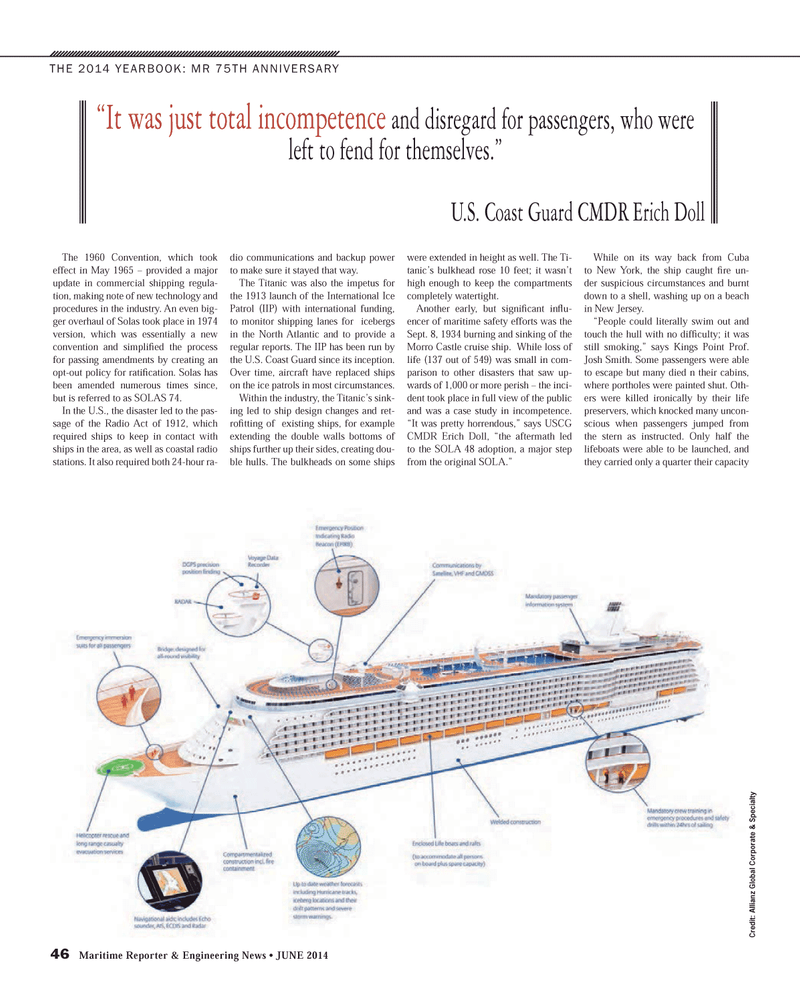
Page 46: of Maritime Reporter Magazine (June 2014)
Annual World Yearbook
Read this page in Pdf, Flash or Html5 edition of June 2014 Maritime Reporter Magazine
46 Maritime Reporter & Engineering News • JUNE 2014
The 1960 Convention, which took effect in May 1965 – provided a major update in commercial shipping regula- tion, making note of new technology and procedures in the industry. An even big- ger overhaul of Solas took place in 1974 version, which was essentially a new convention and simpli? ed the process for passing amendments by creating an opt-out policy for rati? cation. Solas has been amended numerous times since, but is referred to as SOLAS 74.
In the U.S., the disaster led to the pas- sage of the Radio Act of 1912, which required ships to keep in contact with ships in the area, as well as coastal radio stations. It also required both 24-hour ra- dio communications and backup power to make sure it stayed that way.
The Titanic was also the impetus for the 1913 launch of the International Ice
Patrol (IIP) with international funding, to monitor shipping lanes for icebergs in the North Atlantic and to provide a regular reports. The IIP has been run by the U.S. Coast Guard since its inception.
Over time, aircraft have replaced ships on the ice patrols in most circumstances.
Within the industry, the Titanic’s sink- ing led to ship design changes and ret- ro? tting of existing ships, for example extending the double walls bottoms of ships further up their sides, creating dou- ble hulls. The bulkheads on some ships were extended in height as well. The Ti- tanic’s bulkhead rose 10 feet; it wasn’t high enough to keep the compartments completely watertight.
Another early, but signi? cant in? u- encer of maritime safety efforts was the
Sept. 8, 1934 burning and sinking of the
Morro Castle cruise ship. While loss of life (137 out of 549) was small in com- parison to other disasters that saw up- wards of 1,000 or more perish – the inci- dent took place in full view of the public and was a case study in incompetence. “It was pretty horrendous,” says USCG
CMDR Erich Doll, “the aftermath led to the SOLA 48 adoption, a major step from the original SOLA.”
While on its way back from Cuba to New York, the ship caught ? re un- der suspicious circumstances and burnt down to a shell, washing up on a beach in New Jersey. “People could literally swim out and touch the hull with no dif? culty; it was still smoking,” says Kings Point Prof.
Josh Smith. Some passengers were able to escape but many died n their cabins, where portholes were painted shut. Oth- ers were killed ironically by their life preservers, which knocked many uncon- scious when passengers jumped from the stern as instructed. Only half the lifeboats were able to be launched, and they carried only a quarter their capacity
THE 2014 YEARBOOK: MR 75TH ANNIVERSARY “It was just total incompetence and disregard for passengers, who were left to fend for themselves.”
U.S. Coast Guard CMDR Erich Doll
Cr edit: Allianz Global Corporate & Specialty
MR #6 (40-49).indd 46 5/29/2014 9:27:19 AM

 45
45

 47
47
